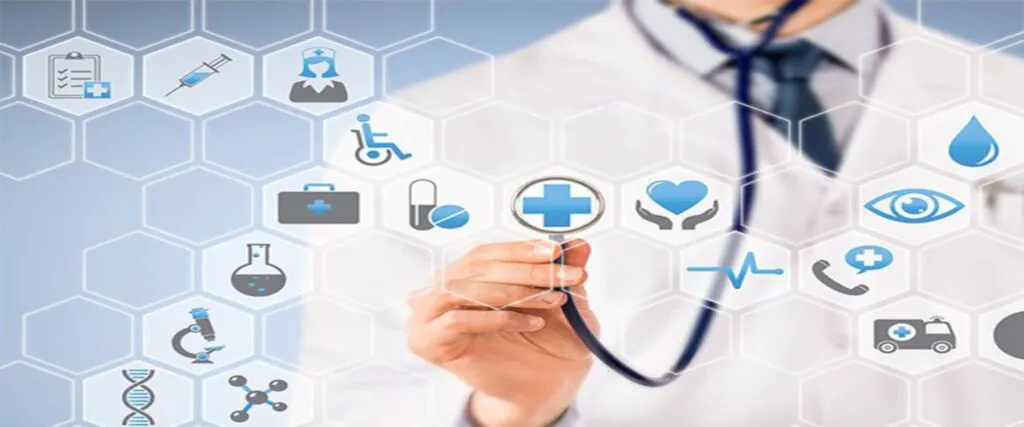Overview of Healthcare Industry
Globally, healthcare is one of the most flourishing sectors and the industry accounts for over 10% of the GDP in most developed nations. The healthcare sector is a major employer worldwide, with millions of people working in various roles, from medical professionals to support staff. The healthcare industry is vital for maintaining public health, advancing medical research, and providing essential healthcare to individuals. It supports millions of jobs globally and significantly contributes to the economy. Additionally, it plays a crucial role in managing and preventing diseases, ensuring a healthier society.
However, this does not mean that this sector is free of challenges. In recent years, healthcare industry companies have been exposed to several predicaments, including economic recession, increase in uninsured healthcare, and growing competition for outpatient services. For instance, the COVID-19 pandemic has had a profound impact on global healthcare, highlighting the importance of robust healthcare systems and accelerating the adoption of telemedicine and digital health solutions. The healthcare industry has also faced significant challenges with data security, with numerous data breaches reported globally.

The healthcare industry consists of businesses that provide medical services, manufacture medical equipment or drugs, provide medical insurance, or otherwise facilitate the provision of healthcare to patients. It includes:
- Medical Equipment and Devices: Companies that manufacture medical instruments, diagnostic equipment, and other devices used in healthcare.
- Medical Services: This includes hospitals, clinics, and other healthcare facilities where patients receive treatment from doctors, nurses, and other medical professionals.
- Health Insurance: Providers that offer health coverage plans to individuals and organizations.
- Support Services: This includes laboratories, diagnostic services, and other ancillary services that support healthcare delivery.
- Public Health and Preventive Services: Focus on improving people’s health by preventing diseases, promoting healthy lifestyles, and implementing programs like vaccinations and screenings
- Clinical Research and Development: Involves studying new treatments and therapies to ensure their safety and effectiveness, ultimately advancing medical knowledge and improving patient care.
Unlock the Future of Healthcare Innovation – Connect with our experts today and take the first step towards transformation…
Key Trends Shaping the Healthcare Sector in Next Five Years
The healthcare sector is experiencing significant transformations in 2024. Here are healthcare industry insights related to the key trends shaping the industry:
Telemedicine and Remote Monitoring
The rise of telemedicine is transforming healthcare by providing patients with remote access to essential services. Remote monitoring devices are increasingly common, allowing for continuous tracking and management of health conditions, enhancing patient care and convenience.
Data Sharing and Interoperability
Healthcare is moving towards enhanced data sharing across many organizations, focusing on developing highly interoperable systems. These systems facilitate secure and seamless exchange of patient information, leading to better patient outcomes, improved care coordination, and more efficient healthcare operations.
Sustainability and Eco-friendly Practices
Healthcare organizations are adopting sustainable practices to minimize their environmental impact. This includes implementing energy-efficient operations and waste reduction strategies, ensuring that the industry contributes positively to environmental sustainability.
Value-based Healthcare
The healthcare industry is rapidly shifting towards value-based care models, which prioritize high-quality care while effectively controlling costs. This approach focuses on improving patient outcomes, enhancing patient satisfaction, and promoting overall healthcare efficiency, rather than simply increasing the volume of services provided.
Aging Population
The growing aging population is driving the need for specialized healthcare services tailored to older adults. This demographic shift requires healthcare systems to adapt, offering customized care solutions to meet the unique needs of this population segment.
AR in Healthcare Training
Augmented reality (AR) is gaining traction in medical training, allowing healthcare providers to visualize diagnoses and procedures in real-time. AR helps address the shortage of trained professionals by enhancing the learning experience and expanding provider skills.
Wearable Devices
Wearable devices are revolutionizing healthcare by keeping patients actively involved in managing their health. These devices monitor metrics like heart rate and blood pressure, encouraging healthier lifestyles and reducing the frequency of doctor visits.
Personalized Healthcare
Data availability enables healthcare companies to personalize treatment for individual patients. Instead of offering standard care to everyone, companies can now use data to identify patient preferences and provide tailored healthcare experiences.
Impact of Technology on Healthcare
Technology has significantly transformed healthcare in numerous ways, enhancing both patient care and the efficiency of healthcare systems. Here are some key impacts:
-
Telehealth & Virtual Care
Telehealth has made healthcare more accessible, allowing patients to consult with doctors remotely. This is especially beneficial for those in rural or underserved areas.
-
Wearable Devices
Devices like fitness trackers and smartwatches monitor vital signs and physical activity, providing real-time health data to both patients and healthcare providers.
-
Artificial Intelligence (AI)
AI is used for diagnosing diseases, predicting patient outcomes, and personalizing treatment plans. It helps in analyzing large datasets to identify patterns and insights that might be missed by people.
-
Electronic Health Records (EHRs)
EHRs have replaced paper records, making it easier to store, retrieve, and share patient information. This improves coordination among healthcare providers and reduces errors.
-
Robotics
Robots assist in surgeries, rehabilitation, and even in routine tasks like dispensing medications. They enhance precision and can perform complex procedures with minimal invasiveness.
-
Data-Driven Decision Making
Advanced data analytics help in making informed decisions about patient care, resource allocation, and public health strategies.
-
Improved Patient Engagement
Digital tools like patient portals and mobile apps empower patients to take an active role in their health management, from scheduling appointments to accessing their medical records.
These advancements are making healthcare more efficient, personalized, and accessible, ultimately leading to better patient outcomes and a more sustainable healthcare system.
Ready to revolutionize your healthcare strategy? Let’s collaborate and drive groundbreaking solutions together…
Challenges in Healthcare Industry
The healthcare industry faces several significant challenges.
| Challenge | What it Entails | Real-world Examples | |
| Financial Constraints | Rising costs and reduced revenues strain hospitals, especially during crises like the COVID-19 pandemic. | Many healthcare facilities struggle to balance budgets while maintaining quality healthcare. | Many hospitals in the U.S. are struggling with rising costs and reduced revenues. For instance, during the COVID-19 pandemic, hospitals faced financial difficulties due to the cancellation of elective surgeries and increased costs for PPE and other supplies. |
| Workforce Shortages | There is a global shortage of healthcare professionals, impacting service delivery. | Rural areas often lack sufficient doctors and nurses, leading to inadequate healthcare. | The shortage of healthcare professionals is a global issue. In India, rural areas often lack sufficient number of doctors and nurses, leading to inadequate healthcare services for the population. |
| Technological Integration | Implementing Electronic Health Records (EHR) systems can be complex and costly. | Integration issues can lead to inefficiencies and increased workloads for staff. | Implementing Electronic Health Records (EHR) systems has been challenging for many healthcare providers. In the U.S., some hospitals have faced difficulties in integrating these systems, leading to inefficiencies and increased workloads for staff. |
| Data Security | Cybersecurity threats pose significant risks to patient data and healthcare operations. | Hospitals have faced disruptions and data breaches, compromising patient information. | Cybersecurity threats are a major concern. In 2020, the University of Vermont Health Network experienced a cyberattack that disrupted services and compromised patient data. |
| Regulatory Compliance | Navigating complex regulations can be challenging for healthcare providers. | Compliance with laws like GDPR impacts how patient data is managed and protected. | Healthcare providers must navigate complex regulations. In the European Union, the General Data Protection Regulation (GDPR) has imposed strict data protection requirements, impacting how healthcare organizations handle patient information. |
| Access to Healthcare | Many people in developing countries live far from healthcare facilities. | Limited access to timely medical attention affects health outcomes. | In many developing countries, access to healthcare is limited. For instance, in sub-Saharan Africa, many people live far from the nearest healthcare facility, making it difficult to receive timely medical attention. |
| Healthcare Disparities among Communities | Significant disparities exist in healthcare access and outcomes among different groups. | Racial and socioeconomic factors contribute to unequal healthcare experiences. | In the U.S., there are significant disparities in healthcare access and outcomes among different racial and socioeconomic groups. For example, African Americans and Hispanics have higher rates of chronic diseases and lower access to quality healthcare than their white counterparts. |
| Aging Population | An aging population increases the demand for long-term care and chronic disease management. | Countries like Japan face pressure on their healthcare systems due to a growing elderly population. | Japan faces a rapidly aging population, which puts pressure on its healthcare system to provide long-term care and manage chronic conditions prevalent among the elderly. |
These challenges require innovative solutions and collaborative efforts from governments, healthcare providers, and the private sector to ensure that healthcare systems can meet the needs of their populations effectively.
The Role of Market Intelligence in Overcoming Healthcare Industry Challenges
Market intelligence in healthcare has several benefits:
-






 Strategic PlanningMarket intelligence offers deep insights into local and global market dynamics, empowering healthcare providers to make well-informed strategic decisions. This enables organizations to identify growth opportunities, optimize resource allocation, and develop competitive strategies that drive success.
Strategic PlanningMarket intelligence offers deep insights into local and global market dynamics, empowering healthcare providers to make well-informed strategic decisions. This enables organizations to identify growth opportunities, optimize resource allocation, and develop competitive strategies that drive success. -






 Improving Patient CareUnderstanding patient preferences and market trends allows healthcare providers to tailor their services more effectively. This leads to improved patient satisfaction and better health outcomes, as services are more aligned with patient needs and expectations.
Improving Patient CareUnderstanding patient preferences and market trends allows healthcare providers to tailor their services more effectively. This leads to improved patient satisfaction and better health outcomes, as services are more aligned with patient needs and expectations. -






 Competitive AdvantagesMarket intelligence helps healthcare organizations stay ahead by monitoring industry trends and innovations. This allows providers to quickly adapt to changing standards of care and regulatory requirements, ensuring they maintain a competitive edge in the market.
Competitive AdvantagesMarket intelligence helps healthcare organizations stay ahead by monitoring industry trends and innovations. This allows providers to quickly adapt to changing standards of care and regulatory requirements, ensuring they maintain a competitive edge in the market. -






 Operational EfficiencyInsights from market intelligence can enhance operational efficiency by pinpointing inefficiencies and suggesting areas for improvement. This can lead to significant cost savings and improved productivity, ultimately benefiting the entire organization.
Operational EfficiencyInsights from market intelligence can enhance operational efficiency by pinpointing inefficiencies and suggesting areas for improvement. This can lead to significant cost savings and improved productivity, ultimately benefiting the entire organization. -






 Regulatory ComplianceStaying updated on regulatory changes and compliance requirements is critical for healthcare providers. Market intelligence aids organizations in navigating complex regulations, helping them avoid potential legal issues and maintain compliance.
Regulatory ComplianceStaying updated on regulatory changes and compliance requirements is critical for healthcare providers. Market intelligence aids organizations in navigating complex regulations, helping them avoid potential legal issues and maintain compliance. -






 Population Health ManagementUnderstanding demographic and epidemiological trends is key to addressing public health challenges. Market intelligence enables healthcare providers to manage population health more effectively, improving outcomes and reducing the strain on healthcare systems.
Population Health ManagementUnderstanding demographic and epidemiological trends is key to addressing public health challenges. Market intelligence enables healthcare providers to manage population health more effectively, improving outcomes and reducing the strain on healthcare systems.
Future of the Healthcare Industry
The future of the healthcare industry is shaped by several emerging trends and ongoing challenges. Here are some key points:
- Telemedicine Expansion: The use of telemedicine has surged, providing remote consultations and reducing the need for in-person visits. This trend is likely to continue, improving access to healthcare, especially in rural and underserved areas.
- AI and ML: AI is being used to enhance diagnostics, predict patient outcomes, and personalize treatment plans. Machine learning algorithms can analyze vast amounts of data to identify patterns and improve decision-making.
- Genomics & Precision Medicine: Advances in genomics are enabling more precise and personalized treatments based on an individual’s genetic makeup. This approach aims to improve the efficacy of treatments and reduce side effects.
- Blockchain for EHRs: Blockchain technology is being explored to secure and streamline the management of electronic health records. It offers a decentralized and tamper-proof way to store and share patient data.
- Mental Health Integration: There is a growing focus on integrating mental health services into primary healthcare. Digital mental health platforms are emerging to provide support and resources.
- Patient-Centered Care: The shift toward patient-centered care emphasizes the importance of involving patients in their own healthcare decisions. This approach aims to improve patient satisfaction and health outcomes.
- Global Health Initiatives: Collaborative efforts to address global health challenges, such as pandemics and chronic diseases, are gaining momentum. Organizations are working together to improve healthcare access and outcomes worldwide.
Conclusion
In conclusion, the importance of the healthcare industry cannot be downplayed or trivialized, especially in the light of global healthcare emergencies like the recent COVID-19 pandemic. Though the healthcare industry as a whole faces an uphill task in overcoming key challenges, especially those related to spiraling healthcare costs, shortage of key healthcare professionals, and increasing data security threats, healthcare facilities and companies operating across the industry will benefit by adapting to healthcare industry changes, such as those given below using the mentioned strategies/technologies:



